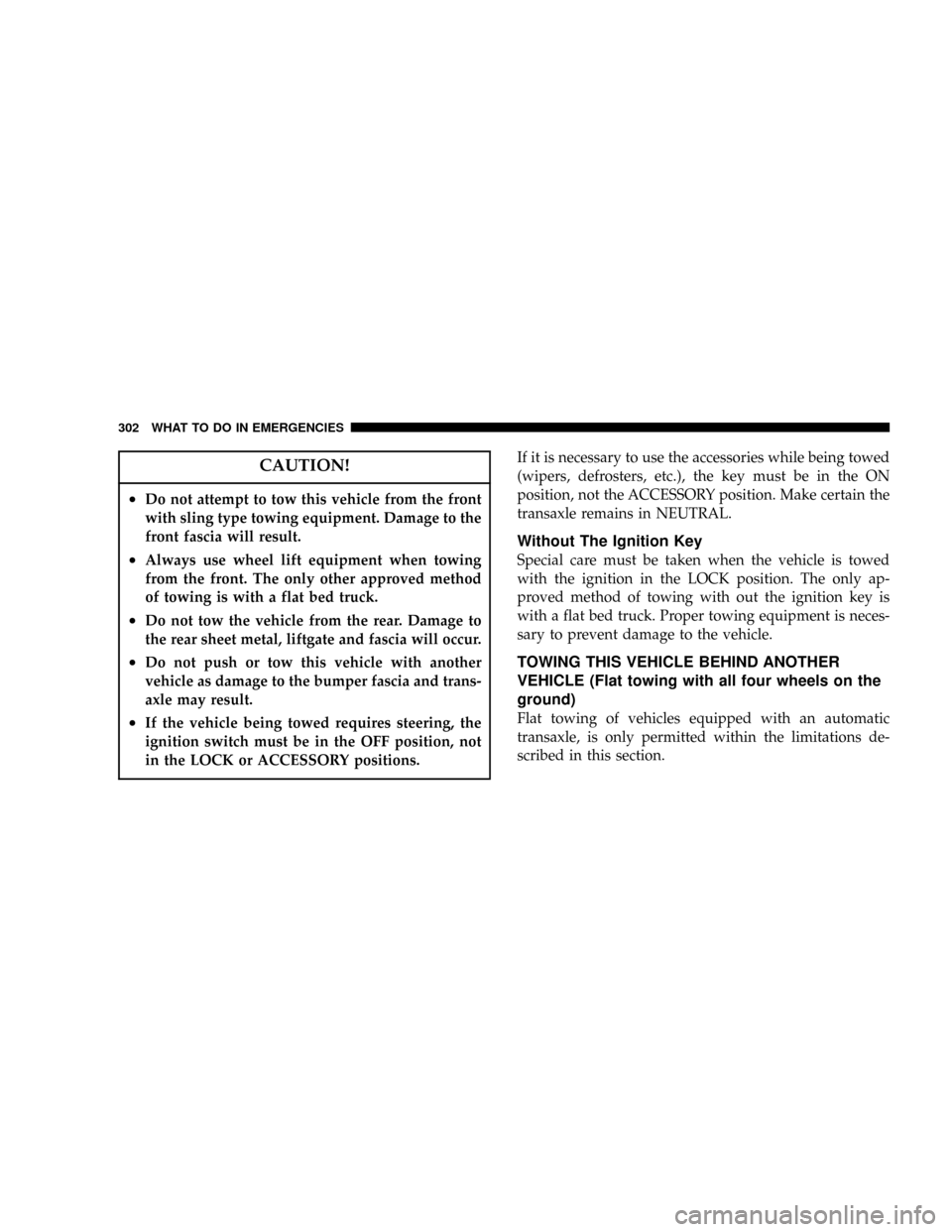CHRYSLER TOWN AND COUNTRY 2004 4.G Owners Manual
Manufacturer: CHRYSLER, Model Year: 2004, Model line: TOWN AND COUNTRY, Model: CHRYSLER TOWN AND COUNTRY 2004 4.GPages: 401
Page 301 of 401

WARNING!
Fast spinning tires can be dangerous. Forces gener-
ated by excessive wheel speeds may cause tire dam-
age or failure. A tire could explode and injure
someone. Do not spin your vehicle's wheels faster
than 35 mph (55 km/h) when you are stuck. And
don't let anyone near a spinning wheel, no matter
what the speed.
CAUTION!
Racing the engine or spinning the wheels too fast
may lead to transmission overheating and failure. It
can also damage the tires. Do not spin the wheels
above 35 mph (55 km/h).
TOWING A DISABLED VEHICLE
With Ignition Key
Front Wheel Drive
Your vehicle may be towed under the following condi-
tions: The gear selector must be in NEUTRAL, the dis-
tance to be traveled must not exceed 100 miles (160 km),
and the towing speed must not exceed 44 mph (72 km/h).
Exceeding these towing limits may cause a transmission
geartrain failure. If the transaxle is not operative, or if the
vehicle is to be towed more than 100 miles (160 km), the
vehicle must be towed with the front wheels off the
ground.
All Wheel Drive Ð If Equipped
Your vehicle may be towed under the following condi-
tions: The gear selector must be in NEUTRAL, the dis-
tance to be traveled must not exceed 100 miles (160 km),
the towing speed must not exceed 44 mph (72 km/h), and
both front and rear wheels must be on the ground. If your
vehicle must be towed farther or at a higher rate of speed,
it must be transported on a flat bed truck.
WHAT TO DO IN EMERGENCIES 301
6
Page 302 of 401

CAUTION!
²Do not attempt to tow this vehicle from the front
with sling type towing equipment. Damage to the
front fascia will result.
²Always use wheel lift equipment when towing
from the front. The only other approved method
of towing is with a flat bed truck.
²Do not tow the vehicle from the rear. Damage to
the rear sheet metal, liftgate and fascia will occur.
²Do not push or tow this vehicle with another
vehicle as damage to the bumper fascia and trans-
axle may result.
²If the vehicle being towed requires steering, the
ignition switch must be in the OFF position, not
in the LOCK or ACCESSORY positions.
If it is necessary to use the accessories while being towed
(wipers, defrosters, etc.), the key must be in the ON
position, not the ACCESSORY position. Make certain the
transaxle remains in NEUTRAL.
Without The Ignition Key
Special care must be taken when the vehicle is towed
with the ignition in the LOCK position. The only ap-
proved method of towing with out the ignition key is
with a flat bed truck. Proper towing equipment is neces-
sary to prevent damage to the vehicle.
TOWING THIS VEHICLE BEHIND ANOTHER
VEHICLE (Flat towing with all four wheels on the
ground)
Flat towing of vehicles equipped with an automatic
transaxle, is only permitted within the limitations de-
scribed in this section.
302 WHAT TO DO IN EMERGENCIES
Page 303 of 401

TOWING THIS VEHICLE BEHIND ANOTHER
VEHICLE WITH A TOW DOLLEY
The manufacturedoes not recommendthat you tow an
All-Wheel Drive (AWD) or front wheel drive vehicle on a
tow dolley. Vehicle damage may occur.
WHAT TO DO IN EMERGENCIES 303
6
Page 304 of 401

Page 305 of 401

MAINTAINING YOUR VEHICLE
CONTENTS
m3.3L/3.8L Engines......................308
mOnboard Diagnostic System Ð OBD II........309
mEmissions Inspection And Maintenance
Programs............................310
mReplacement Parts......................311
mDealer Service.........................311
mMaintenance Procedures..................312
NEngine Oil..........................313
NEngine Oil Filter......................316NDrive Belts Ð Check Condition And Tension . . 316
NSpark Plugs.........................317
NEngine Air Cleaner Filter................317
NEngine Fuel Filter.....................318
NCatalytic Converter....................318
NMaintenance-Free Battery................319
NAir Conditioner......................321
NPower Steering Ð Fluid Check............322
NFront Suspension Ball Joints..............323
7
Page 306 of 401

NSteering Shaft Seal....................323
NSteering Linkage......................323
NDrive Shaft Universal Joints..............323
NBody Lubrication.....................324
NWindshield Wiper Blades................324
NWindshield And Rear Window Washers.....324
NExhaust System......................325
NCooling System.......................326
NHoses And Vacuum/Vapor Harnesses.......331
NBrakes.............................331
NMaster Cylinder Ð ABS Brakes Brake Fluid
Level Check.........................333
NFuel System Hoses....................334NAutomatic Transmission................335
NAll Wheel Drive (AWD).................337
NFront And Rear Wheel Bearings...........339
NAppearance Care And Protection
From Corrosion......................339
NCleaning The Instrument Panel And Underseat
Cup Holders........................343
mIntegrated Power Module (IPM)............344
mVehicle Storage........................345
mReplacement Light Bulbs.................346
mBulb Replacement......................347
NHeadlights..........................347
NFront Park/Turn Signal And
Sidemarker Lights.....................348
306 MAINTAINING YOUR VEHICLE
Page 307 of 401

NFront Fog Light......................349
NRear Tail, Stop, Turn Signal, Side Marker And
Back-Up Lights.......................350
NCenter High Mounted Stop Light (CHMSL) . . . 351
NLicense Light........................351mFluid Capacities........................351
mRecommended Fluids, Lubricants And
Genuine Parts.........................352
NEngine.............................352
NChassis............................353
MAINTAINING YOUR VEHICLE 307
7
Page 308 of 401

3.3L/3.8L ENGINES
308 MAINTAINING YOUR VEHICLE
Page 309 of 401

ONBOARD DIAGNOSTIC SYSTEM Ð OBD II
Your vehicle is equipped with a sophisticated onboard
diagnostic system called OBD II. This system monitors
the performance of the emissions, engine, and automatic
transmission control systems. When these systems are
operating properly, your vehicle will provide excellent
performance and fuel economy, as well as engine emis-
sions well within current government regulations.
If any of these systems require service, the OBD II system
will turn on the ªMalfunction Indicator Light.º It will
also store diagnostic codes and other information to
assist your service technician in making repairs. Al-
though your vehicle will usually be drivable and not
need towing, see your dealer for service as soon as
possible.CAUTION!
Prolonged driving with the ªMalfunction Indicator
Lightº on could cause further damage to the emis-
sion control system. It could also affect fuel economy
and driveability. The vehicle must be serviced before
any emissions tests can be performed.
If the ªMalfunction Indicator Lightº is flashing
while the engine is running, severe catalytic con-
verter damage and power loss will soon occur. Im-
mediate service is required.
MAINTAINING YOUR VEHICLE 309
7
Page 310 of 401

EMISSIONS INSPECTION AND MAINTENANCE
PROGRAMS
In some localities, it may be a legal requirement to pass
an inspection of your vehicle's emissions control system.
Failure to pass could prevent vehicle registration.
For states which have an I/M (Inspection and
Maintenance) requirement, this check verifies the
following: the MIL (Malfunction Indicator Lamp)
is functioning and is not on when the engine is running,
and that the OBD (On Board Diagnostic) system is ready
for testing.
Normally, the OBD system will be ready. The OBD
system maynotbe ready if your vehicle was recently
serviced, if you recently had a dead battery, or a battery
replacement. If the OBD system should be determined
not ready for the I/M test, your vehicle may fail the test.Your vehicle has a simple ignition key actuated test
which you can use prior to going to the test station. To
check if your vehicle's OBD system is ready, you must do
the following:
1. Insert your ignition key into the ignition switch.
2. Turn the ignition to the ON position, but do not crank
or start the engine.
3. If you crank or start the engine, you will have to start
this test over.
4. As soon as you turn your key to the ON position, you
will see your MIL symbol come on as part of a normal
bulb check.
5. Approximately 15 seconds later, one of two things will
happen:
a. The MIL will flash for about 10 seconds and then
return to being fully illuminated until you turn off the
310 MAINTAINING YOUR VEHICLE